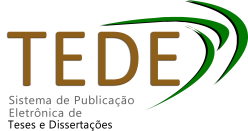| Compartilhamento |


|
Use este identificador para citar ou linkar para este item:
http://www.bdtd.ueg.br/handle/tede/291Registro completo de metadados
| Campo DC | Valor | Idioma |
|---|---|---|
| dc.creator | Silva, Andrei Severino Ferreira da | - |
| dc.creator.Lattes | http://lattes.cnpq.br/7373380741231027 | por |
| dc.contributor.advisor1 | Toschi, Mirza Seabra | - |
| dc.contributor.advisor1Lattes | http://lattes.cnpq.br/3959962750556696 | por |
| dc.contributor.referee1 | Tavares, Giovana Galvão | - |
| dc.contributor.referee2 | Araújo, Cleide Sandra Tavares | - |
| dc.date.accessioned | 2020-04-07T16:59:03Z | - |
| dc.date.issued | 2015-02-26 | - |
| dc.identifier.citation | SILVA, Andrei Severino Ferreira da. Parque estadual serra de caldas novas (pescan): ecoturismo, compreensões de meio ambiente e práticas ambientais dos visitantes. 2015. 185 f. Dissertação (Mestrado em Recursos Naturais do Cerrado) - Câmpus Central - Sede: Anápolis - CET, Universidade Estadual de Goiás, Anápolis. | por |
| dc.identifier.uri | http://www.bdtd.ueg.br/handle/tede/291 | - |
| dc.description.resumo | As Unidades de Conservação (UC) têm se apresentado como instrumentos capazes de promover a proteção ambiental e possibilitar o contato de visitantes com o meio natural protegido, despertando neles o interesse pelas questões ambientais. O presente estudo teve como proposta investigar o uso público do Parque Estadual Serra de Caldas Novas (PESCaN), localizado nos municípios goianos de Caldas Novas e Rio Quente, com o objetivo geral de: “compreender o ecoturismo no PESCaN e conhecer e analisar as compreensões de meio ambiente e de Educação Ambiental (EA) que os visitantes da UC possuem e as ações ambientais que os mesmos praticam”. Os objetivos específicos incluíram: i. Conhecer e analisar os objetivos que levam os visitantes do PESCaN a buscá-lo em seu tempo livre; ii. Interpretar o grau de importância e de conhecimento das questões relacionadas ao meio ambiente dos visitantes; iii. Analisar as compreensões da temática da EA dos visitantes; iv. Investigar e analisar as ações em prol do meio ambiente praticadas pelos visitantes, conforme discurso deles; v. Investigar se as compreensões de meio ambiente dos visitantes se alteram depois de percorrido o passeio; e vi. Analisar de que forma as atividades ecoturísticas veem sendo desenvolvidas no PESCaN. A metodologia estruturou-se em torno de pesquisa bibliográfica e pesquisa de campo. A primeira, com base na fundamentação teórica de autores como: Wearing e Neil (2001); Costa (2002); Kinker (2002); Takahashi e Milano (2002); Barros (2003); Pires (2004); Jacobi et al (2004); Magalhães (2005); Dutra et al (2008); Ramos e Oliveira (2008); Freitas (2009); Medeiros e Araújo (2011); Soibert e Oliveira (2011); Simonetti e Nascimento (2012); Muhle (2012); entre outros, que discutem assuntos relacionados à temática ambiental, ao turismo e ecoturismo, à utilização e conservação de áreas protegidas e ao estudo das compreensões e características dos visitantes. A segunda, com base na investigação conduzida por meio da aplicação de questionário aos visitantes, à entrada e à saída do PESCaN, como forma de analisar suas características socioeconômicas, as compreensões de meio ambiente, as práticas ambientais realizadas por eles, e se o parque altera essas compreensões depois de percorrido o passeio. Foram entrevistados 273 visitantes e os resultados apontaram índices satisfatórios para o PESCaN e para o trato com as questões ambientais: mais da metade dos pesquisados buscam a unidade para realizar pesquisas científicas, atividades escolares ou visitas técnicas; cerca de um terço vão ao parque para conhecer a unidade, seus atrativos e o Cerrado goiano; quase 70% possuem o costume de visitar outras UC. O meio ambiente é considerado como um sistema de integração e interação entre o homem e a natureza por quase 85% dos visitantes, resultado que se manteve à entrada e à saída no parque; pouco mais de 90% realizam ações em prol do meio ambiente, principalmente as relacionadas com reciclagem/coleta seletiva, economia de água e projetos de conscientização ambiental. O interesse por realizar algum programa de EA após a visita ao parque foi manifestada por 90% dos visitantes, principalmente de algum programa relacionado com a conservação do meio ambiente ou com a conscientização de estudantes e/ou sociedade. A unidade foi avaliada com nota de 9,0 a 10,0 por quase 63% dos entrevistados; a quase totalidade visitaria o parque novamente e indicaria a visita a amigos e parentes. A existência de Conselho Consultivo atuante e a definição de Zona de Amortecimento são pontos favoráveis para a gestão da UC. A falta de regulamentação do Plano de Manejo, a baixa utilização da estrutura do parque e o pouco envolvimento dos funcionários com as atividades realizadas são apontados como pontos desfavoráveis. | por |
| dc.description.abstract | The Conservation Unities (CU) have been considered as tools able to promote the environmental protection, and they also enable the visitors contact with the protected environment, arousing them the interest for environmental issues. The present study has the purpose of investigate the public use of the Serra de Caldas Novas State Park (PESCaN), located in the municipalities of Goiás, Caldas Novas and Rio Quente, with the general goal of: “understand the ecotourism at PESCaN, and know and analyze the understandings of the environment and of the Environmental Education (EE) that the visitors from the UC have, and also the environmental actions they perform”. The specific goals included: i. Get to know and analyze the goals that take the visitors at PESCaN to look for it at their free time; ii. Interpret the rate of significance and knowledge of the visitors about the issues related to the environment; iii. Analyze the understanding of the EE theme of the visitors; iv. Investigate and analyze the actions in favor of the environment practiced by the visitors, according to their speech; v. Investigate whether the environmental understanding of the visitors change after the tour; and vi. Analyze the way the ecotourism activities are being developed at PESCaN. The methodology was structured through bibliographic research and field research. The former is based on the authors‟ theories such as: Wearing and Neil (2001); Costa (2002); Kinker (2002); Takahashi and Milano (2002); Barros (2003); Pires (2004); Jacobi et al (2004); Magalhães (2005); Dutra et al (2008); Ramos and Oliveira (2008); Freitas (2009); Medeiros and Araújo (2011); Soibert and Oliveira (2011); Simonetti and Nascimento (2012); Muhle (2012); among others, who discuss subjects related to the themes of the environment, the tourism and the ecotourism, and also related to the use and conservation of protected areas, and the study of understanding and characteristics of visitors. The latter, based on the conducted investigation through the survey applied to the visitors, when they arrived and left PESCaN, as a way to analyze their socioeconomic characteristics, the environmental understanding, their environmental practices, and whether the park changes these understandings after the tour. In addition, 273 visitors were interviewed, and the results showed satisfactory rates for PESCaN and for the treatment of environmental issues: more than half of the interviewed look for the unity to perform scientific researches, school activities or technical visitation; about one third go to the park to know the unity, its attractions and the Cerrado; nearly 70% of the interviewed have the habit to visit other CU. The environment is considered as a system of integration and interaction between man and nature for nearly 85% of the visitors, a result held in the entrance and in the exit of the park; a few more than 90% act in favor of the environment, mainly when it is related to recycling/ selective collection, saving water and projects of environmental awareness. The interest to participate in any EE program after the tour in the park was expressed by 90% of the visitors, mainly related to a program connected to the environmental conservation or with students and/or society awareness. The unity was evaluated with the grade from 9,0 to 10,0 for almost 63% of the interviewed; nearly everyone would visit the park again and they would suggest the visit to friends and relatives. The existence of an active Advisory Council and the definition of Buffer Zone are favorable points for the CU management. The lack of regulation of the Management Plan, the low use of the park structure and the little involvement of the employees with the activities are showed as unfavorable points. | por |
| dc.description.provenance | Submitted by Sandra Barbosa (sandrabarbosa632@gmail.com) on 2020-04-07T16:59:03Z No. of bitstreams: 2 license.txt: 2138 bytes, checksum: 77209788b6548b0520e61e670bd90d68 (MD5) Andrei Severino.pdf: 7606311 bytes, checksum: 7b52a8864203aa42934a080186ea4da9 (MD5) | eng |
| dc.description.provenance | Made available in DSpace on 2020-04-07T16:59:03Z (GMT). No. of bitstreams: 2 license.txt: 2138 bytes, checksum: 77209788b6548b0520e61e670bd90d68 (MD5) Andrei Severino.pdf: 7606311 bytes, checksum: 7b52a8864203aa42934a080186ea4da9 (MD5) Previous issue date: 2015-02-26 | eng |
| dc.description.sponsorship | Coordenação de Aperfeiçoamento de Pessoal de Nível Superior - CAPES | por |
| dc.description.sponsorship | Fundação de Apoio à pesquisa do Estado de Goiás - FAPEG | por |
| dc.format | application/pdf | * |
| dc.language | por | por |
| dc.publisher | Universidade Estadual de Goiás | por |
| dc.publisher.department | UEG ::Coordenação de Mestrado em Recursos Naturais | por |
| dc.publisher.country | Brasil | por |
| dc.publisher.initials | UEG | por |
| dc.publisher.program | Programa de Pós-Graduação Stricto sensu em Recursos Naturais do Cerrado RENAC | por |
| dc.rights | Acesso Aberto | por |
| dc.subject | Unidade de conservação | por |
| dc.subject | Educação ambiental | por |
| dc.subject | Ecoturismo e práticas ambientais | por |
| dc.subject | Proteção ambiental | por |
| dc.subject | Visitação pública | por |
| dc.subject | Conservation unity and | eng |
| dc.subject | Environmental education | eng |
| dc.subject | Ecotourism and environmental practices | eng |
| dc.subject | Environmental protection | eng |
| dc.subject | Public visitation | eng |
| dc.subject.cnpq | CIENCIAS BIOLOGICAS | por |
| dc.title | Parque estadual serra de caldas novas (pescan): ecoturismo, compreensões de meio ambiente e práticas ambientais dos visitantes | por |
| dc.type | Dissertação | por |
| Aparece nas coleções: | Mestrado em Recursos Naturais do Cerrado (RENAC) | |
Arquivos associados a este item:
| Arquivo | Descrição | Tamanho | Formato | |
|---|---|---|---|---|
| Andrei Severino.pdf | 7,43 MB | Adobe PDF | Baixar/Abrir Pré-Visualizar |
Os itens no repositório estão protegidos por copyright, com todos os direitos reservados, salvo quando é indicado o contrário.




